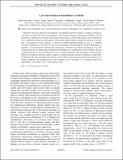| dc.contributor.author | Pezzulla, Matteo | |
| dc.contributor.author | Stoop, Norbert | |
| dc.contributor.author | Steranka, Mark P. | |
| dc.contributor.author | Bade, Abdikhalaq J. | |
| dc.contributor.author | Holmes, Douglas P. | |
| dc.date.accessioned | 2018-03-27T18:12:35Z | |
| dc.date.available | 2018-03-27T18:12:35Z | |
| dc.date.issued | 2018-01 | |
| dc.date.submitted | 2017-12 | |
| dc.identifier.issn | 0031-9007 | |
| dc.identifier.issn | 1079-7114 | |
| dc.identifier.uri | http://hdl.handle.net/1721.1/114412 | |
| dc.description.abstract | Induced by proteins within the cell membrane or by differential growth, heating, or swelling, spontaneous curvatures can drastically affect the morphology of thin bodies and induce mechanical instabilities. Yet, the interaction of spontaneous curvature and geometric frustration in curved shells remains poorly understood. Via a combination of precision experiments on elastomeric spherical shells, simulations, and theory, we show how a spontaneous curvature induces a rotational symmetry-breaking buckling as well as a snapping instability reminiscent of the Venus fly trap closure mechanism. The instabilities, and their dependence on geometry, are rationalized by reducing the spontaneous curvature to an effective mechanical load. This formulation reveals a combined pressurelike term in the bulk and a torquelike term in the boundary, allowing scaling predictions for the instabilities that are in excellent agreement with experiments and simulations. Moreover, the effective pressure analogy suggests a curvature-induced subcritical buckling in closed shells. We determine the critical buckling curvature via a linear stability analysis that accounts for the combination of residual membrane and bending stresses. The prominent role of geometry in our findings suggests the applicability of the results over a wide range of scales. | en_US |
| dc.publisher | American Physical Society | en_US |
| dc.relation.isversionof | http://dx.doi.org/10.1103/PhysRevLett.120.048002 | en_US |
| dc.rights | Article is made available in accordance with the publisher's policy and may be subject to US copyright law. Please refer to the publisher's site for terms of use. | en_US |
| dc.source | American Physical Society | en_US |
| dc.title | Curvature-Induced Instabilities of Shells | en_US |
| dc.type | Article | en_US |
| dc.identifier.citation | Pezzulla, Matteo et al. "Curvature-Induced Instabilities of Shells." Physical Review Letters 120, 4 (January 2018): 048002 © 2018 American Physical Society | en_US |
| dc.contributor.department | Massachusetts Institute of Technology. Department of Mathematics | en_US |
| dc.contributor.mitauthor | Stoop, Norbert | |
| dc.relation.journal | Physical Review Letters | en_US |
| dc.eprint.version | Final published version | en_US |
| dc.type.uri | http://purl.org/eprint/type/JournalArticle | en_US |
| eprint.status | http://purl.org/eprint/status/PeerReviewed | en_US |
| dc.date.updated | 2018-02-07T20:54:47Z | |
| dc.language.rfc3066 | en | |
| dc.rights.holder | American Physical Society | |
| dspace.orderedauthors | Pezzulla, Matteo; Stoop, Norbert; Steranka, Mark P.; Bade, Abdikhalaq J.; Holmes, Douglas P. | en_US |
| dspace.embargo.terms | N | en_US |
| dc.identifier.orcid | https://orcid.org/0000-0002-9093-0193 | |
| mit.license | PUBLISHER_POLICY | en_US |
